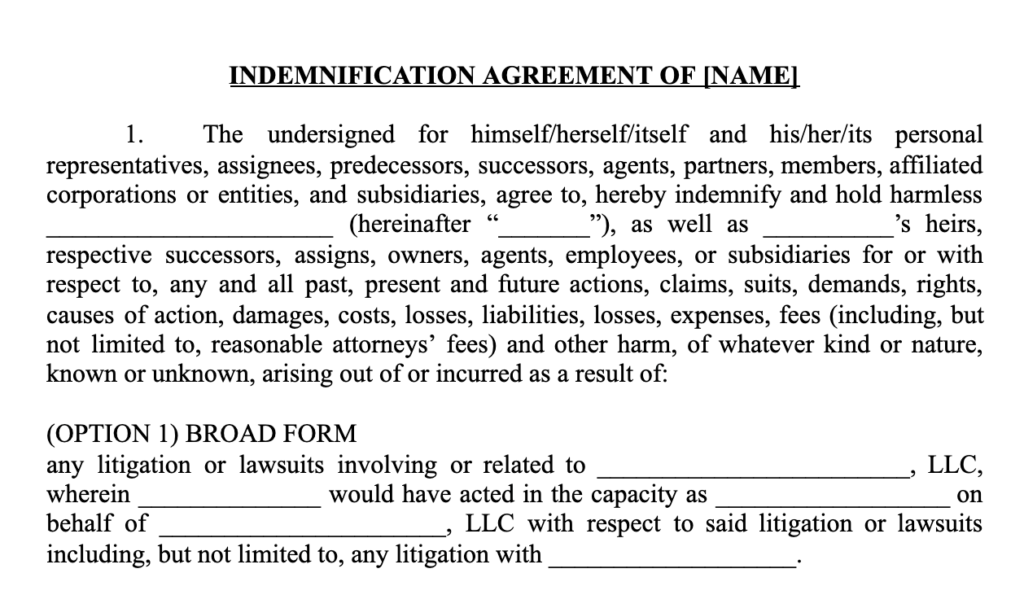
There are a lot of risks involved in construction projects and the industry as a whole. Between physical safety, materials pricing, delays, and hundreds of other gambles, things can happen. And while those risks might not be avoidable, their effects might be transferable — and that’s exactly what a hold harmless agreement does.
If you’re considering transferring some of the risk involved in the form of liability or losses, confused about a hold harmless agreement in one of your contracts, or you’re searching for a template, keep reading.
What is a hold harmless agreement?
According to Merriam-Webster, a hold harmless agreement is “an agreement between parties in which one assumes the potential liability for injury that may arise from a situation and thus relieves the other of liability.”
So what does that mean in simple, construction terms?
A hold harmless agreement in a construction contract is a clause that states one party (usually the subcontractor) will not hold the other party (usually the GC or project owner) legally or financially responsible for losses incurred or accidents and negligence caused to the other party while under the contract. It’s a useful risk management tool to contract off liability.
There are three types of hold harmless agreements:
- Broad form hold harmless agreements are used to shift almost all the liability to the subcontractor. Under these agreements, the subcontractor assumes responsibility for its own negligence and accidents, the negligence or accidents of the general contractor, and negligence or accidents on the part of both the GC and the sub. Many jurisdictions disallow this type of agreement.
- Intermediate form agreements are a bit more reasonable. Under these clauses, the subcontractor agrees to be solely responsible for its own actions, and cannot be held responsible for the general contractor’s accidents or negligence. This is one of the most popular agreement types.
- Limited form agreements hold the subcontractor liable only for their proportional part of the negligence or accident. So, if the GC and the sub are negligent, but it’s determined that only a small fraction of the loss or accident is the subs fault, their liability is lessened.

Free hold harmless agreement template
Download a free template provided by construction attorney Christian D. Game, Esq.
To hold harmless or indemnify: What’s the difference?
In many situations, “hold harmless” and “indemnify” are thought to be interchangeable, but they aren’t exactly the same. One protects against losses, while the other protects against liabilities and losses. Let’s dissect that first:
- In construction terms, a loss is typically a financial cost or deficit caused by an action, whether it be an accident or negligence. Essentially, it’s the money involved in a mistake.
- Liabilities in construction would refer to the legal consequences caused by an action, again, by accident or negligence.
An indemnification clause will protect the indemnee from financial losses, allowing them to be made whole for expenses, losses, damages, and other financial risks. A hold harmless agreement protects against both losses and liabilities. So not only will a sub have to make the GC whole for financial losses, they also will not be able to pursue litigation for any injuries caused by accidents or negligence.
There are states that see the two terms as interchangeable. Those states include Ohio, Colorado, Louisiana, and Delaware. On the other hand, California sees them as two very different terms. During the Queen Villas Homeowners Assn V. TCB Property Management case, the court ruled that indemnification was an offensive right and hold harmless is a defensive measure.
Regardless of how a state’s construction law sees the two terms, many contracts often attempt to cover all the bases by explicitly calling for both clauses. Those contracts will state that a party will “indemnify, defend, and hold harmless” the other party to the contract.
“The most important provisions as they relate to your article are found in Section 1,” Game says of the hold harmless template.
If you use the template provided, you still need to attain the opinion of counsel.
Examples of hold harmless clauses in construction contracts
It might be helpful to have a few examples of hold harmless agreements for reference and context. In fact, a contract could potentially contain several clauses, so it’s a good idea to familiarize yourself with each.
General performance
A hold harmless clause protecting against general performance would be the most universal language one could use for protection during any construction project.
“The Contractor shall defend, indemnify and hold the County, its officers, officials, employees and volunteers harmless from any and all claims, injuries, damages, losses or suits including attorney fees, arising out of or in connection with the performance of this Agreement, except for injuries and damages caused by the sole negligence of the Owner.
In the event of liability for damages arising out of bodily injury to persons or damages to property caused by or resulting from the concurrent negligence of the Contractor and the Owner, its officers, officials, employees, and volunteers, the Contractor’s liability hereunder shall be only to the extent of the Contractor’s negligence.”
Infringement
A hold harmless agreement protecting against infringement could be important in regard to the design and use of particular materials. Should a suit be filed for infringement, the contractor accepts the responsibility.
“The Contractor agrees to fully defend, indemnify, and hold harmless the Indemnified Persons against any demand, claim, cause of action, suit, proceeding, or judgment that any service or design, or product called for in any service or design, provided by any Contractor-Related Entity (herein called “deliverables”) that infringes or allegedly infringes any patent, copyright, trademark, service mark, trade dress, utility model, industrial design, mask work, trade secret or other proprietary right of a third party.”
Design defects
In an ideal world, the designs and drawings will translate perfectly to the job site, but that never happens. In those cases where the design is inadequate or omits an element, a hold harmless agreement prevents the contractor from legal action against the designer or project owner. That’s not to say that they can’t reach an amicable agreement with change orders or other means.
“The Contractor shall fully defend, indemnify and hold harmless the Indemnified Persons from any and all third party claims, demands, causes of action, damages, losses, and expenses (including attorney’s fees) of whatsoever nature, character, or description arising out of or related to errors, omissions, inconsistencies, inaccuracies, deficiencies or other defects in the design documents furnished by the Contractor, regardless of whether such errors, omissions, inconsistencies, inaccuracies, deficiencies or other defects were also included in the Directive Drawings, Preliminary Design or other Reference Documents. The Contractor agrees that, because the Directive Drawings, Preliminary Design and other Reference Documents are preliminary and conceptual in nature and are subject to review and modification by the Contractor, such documents shall not be deemed “design furnished” by the Authority or any of the other Indemnified Persons, as the term “design furnished” is used in Civil Code Section 2782. The Contractor hereby waives the benefit (if any) of Civil Code Section 2782 and agrees that this clause constitutes an agreement governed by Civil Code Section 2782.5.”
Third parties
On occasion, a contract might contain language that protects not only the project owner or the GC, but also some additional third parties against claims. This could include designers, other contractors, consultants, and many more examples.
“The Contractor is specifically advised that third party agreements include certain agreements by the Authority to indemnify, defend and hold harmless the third parties. The Contractor’s obligations under this “Indemnification and Infringement” clause shall automatically apply to require it to release, indemnify, defend and hold harmless the third parties in addition to the Indemnified Persons, with respect to all such matters to the extent that such matters fall within the scope of the indemnities made by the Contractor as set forth in this “Indemnification and Infringement” clause.
Payment problems
Some hold harmless agreements might include a payment clause which basically states that if the contractor or sub doesn’t pay its subs and suppliers, there can be no repercussions from the GC or sub to the project owner (or GC, in some cases). This does not remove the possibility of a mechanics lien.
“To the fullest extent allowed by law, Subcontractor shall indemnify, defend and hold harmless the Contractor and Owner from and against all claims, damages, losses and expenses, including but not limited attorneys’ fees, arising out of or resulting from the failure of the Subcontractor to ensure that all of its subcontractors, suppliers, employees and others involved in the performance of the Subcontract are, at all times, paid all amounts due in connection therewith.”
Make sure your hold harmless agreements are crystal clear
Hold harmless agreements can be very effective risk management tools, but they need to be crystal clear. They need to spell out the situations the agreement covers without any room for misinterpretation. Ambiguous clause agreements are ripe for expensive and time-consuming legal disputes rather than avoiding them.
If your plan is to utilize a hold harmless agreement to minimize your liability on a project, or you’re signing a contract containing one, be sure you understand exactly how they work and what yours entails. They’re excellent tools when handled correctly.
